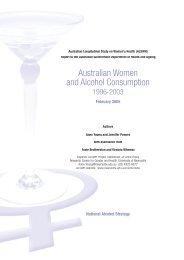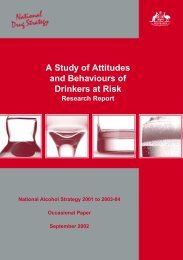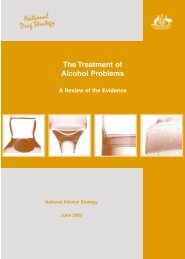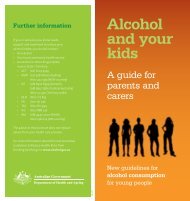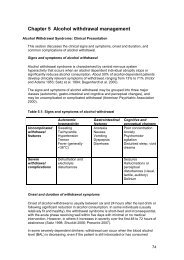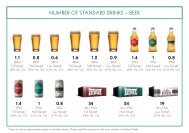Comprehensive Clinical AssessmentA comprehensive clinical <strong>assessment</strong> should be conducted before developing acomprehensive <strong>treatment</strong> plan for those drinkers who have not responded to adviceto reduce their consumption of alcohol, have severe alcohol-related problems <strong>and</strong> inpatients who asked for or need help to deal with their drinking.Assessment should combine a variety of techniques for gathering information aboutthe patient, including diagnostic interviews, physical examination, biological markers<strong>and</strong> clinical investigations as well as collateral information from significant others.The areas for <strong>assessment</strong> include: motivation to change, alcohol consumptionpattern <strong>and</strong> severity of dependence, alcohol-related harms (such as physical <strong>and</strong>psychological health problems, relationship problems, occupational problems <strong>and</strong>legal problems), family factors <strong>and</strong> cognitive functioning.The need for comprehensive <strong>assessment</strong> must be balanced with the desire toengage <strong>and</strong> retain the patient in <strong>treatment</strong>. If the patient perceives that little or noprogress is being made in the first sessions, their motivation to stay in <strong>treatment</strong> mayreduce.Purpose of <strong>assessment</strong>Assessment has three important functions:a) to assist the patient <strong>and</strong> clinician to identify shared <strong>treatment</strong> goals <strong>and</strong>develop a <strong>treatment</strong> plan;b) to engage the patient in the <strong>assessment</strong> <strong>and</strong> <strong>treatment</strong> process;c) to motivate the patient to change drinking patterns <strong>and</strong> related behaviour.The patient’s perception of a gap between their goals <strong>and</strong> their present state mayimprove motivation for change (Miller <strong>and</strong> Rollnick 2002; Miller 1995).Recommendation3.10 Assessment should include patientinterview, structured questionnaires, physicalexamination, clinical investigations <strong>and</strong>collateral history. The length of the <strong>assessment</strong>should be balanced against the need to keepthe patient in <strong>treatment</strong> <strong>and</strong> address immediateconcerns.Strength ofrecommendationDLevel ofevidenceIVDiagnostic interviewsThe initial <strong>assessment</strong> procedure ideally takes the form of an open-ended, semistructuredinterview where the patient <strong>and</strong> the clinician compile a narrative history,using questionnaires as appropriate <strong>and</strong> necessary. This has the advantage ofclinician involvement which is personal <strong>and</strong> responsive to the drinker, rather thanmechanical <strong>and</strong> impersonal. Yet, it should maintain a purposeful structure so as toavoid a vague, directionless discussion of the drinker’s history.St<strong>and</strong>ardised questionnaires are not often used, but a number of validated26
instruments may be useful in selected cases. Structured diagnostic interviews areavailable but infrequently used in clinical practice. Examples include: CompositeInternational Diagnostic Interview (CIDI), the Schedules for Clinical Assessment inNeuropsychiatry (SCAN) <strong>and</strong> the <strong>Alcohol</strong> Use Disorder <strong>and</strong> Associated DisabilitiesInterview Schedule-<strong>Alcohol</strong>/Drug-Revised (AUDADIS-ADR).The Composite International Diagnostic Interview (CIDI) is a st<strong>and</strong>ardised <strong>and</strong>comprehensive interview designed to assess psychological disorders against theInternational Classification of Diseases (ICD) <strong>and</strong> DSM-IV diagnoses (World HealthOrganisation 1990). It must be administered or supervised by a fully trained mentalhealth professional who has undertaken recognised CIDI training. As well assubstance use disorders, it covers eating disorders, organic mental disorders,schizophrenic disorders, paranoid disorders, affective disorders, anxiety disorders,somatisation disorders, dissociative disorders, <strong>and</strong> psychosexual disorders. WHOalso recently produced the World Mental Health (WMH) Survey Initiative version(Kessler <strong>and</strong> Ustun 2004). However, one study found that CIDI performed poorly,especially in diagnosing social phobia <strong>and</strong> post-traumatic stress disorder, comparedto clinical <strong>assessment</strong> (Komiti et al. 2001).The CIDI, the Schedules for Clinical Assessment in Neuropsychiatry (SCAN) <strong>and</strong> the<strong>Alcohol</strong> Use Disorder <strong>and</strong> Associated Disabilities Interview Schedule-<strong>Alcohol</strong>/Drug-Revised (AUDADIS-ADR) all have reasonable test-retest reliability <strong>and</strong> diagnosticconcordance for alcohol dependence, but not for risky alcohol use or abuse.Assessing level <strong>and</strong> history of alcohol consumptionThe <strong>assessment</strong> process should gather information about the drinking history,including how the drinking pattern evolved, fluctuated <strong>and</strong>/or progressed over time.The history should include the daily average consumption (grams per day orst<strong>and</strong>ard drinks per day) of alcohol, the number of drinking days per week (or month)<strong>and</strong> the pattern of drinking.There is limited community recognition of a st<strong>and</strong>ard drink (Kaskutas <strong>and</strong> Kerr 2008)(Gill et al. 2007). Based on cumulative population self-report, overall alcohol use isunder-reported, but interviewing style influences the accuracy of self-report(Stockwell et al. 2004; Stockwell et al. 2008). For example, the Lifetime DrinkingHistory that examines alcohol use throughout the life span has been shown to be avalid <strong>assessment</strong> (Koenig et al. 2009).There are several structured methods available to perform <strong>assessment</strong> of alcoholconsumption, although these are not routinely used in clinical practice. The TimelineFollow-back Method (TLFB) helps to obtain an accurate, retrospective account ofalcohol consumption over a particular period, typically three months. This methodrequires the patient <strong>and</strong> clinician to fill in a blank calendar with a detailed descriptionof alcohol consumption. The patient is first asked to note all events that may assistwith recall, for example public holidays or significant personal events. Any personaldiaries may help with recall. The patient then fills in the drinking days, noting theamount consumed, <strong>and</strong> perhaps also the number of hours of consumption. This canbe extended to obtain a life-time drinking history which is useful for research <strong>and</strong>occasionally for other purposes, but is time consuming <strong>and</strong> of moderate accuracy(Sobell <strong>and</strong> Sobell 1992).27
- Page 5 and 6: The third question of the AUDIT tak
- Page 7 and 8: Two screening instruments - TWEAK a
- Page 9: CDT and GGT are used in some clinic
- Page 13 and 14: theory has been tested widely, most
- Page 15 and 16: compulsive drinking style. The vali
- Page 17 and 18: A limited range of measures of ment
- Page 19 and 20: education, ethnic background, langu
- Page 21 and 22: Assessing riskFull risk assessment
- Page 23 and 24: expressed preference for moderation
- Page 25 and 26: ReferencesAertgeerts, B, Buntinx F,
- Page 27 and 28: Dawe, S, Loxton N, Hides L et al. 2
- Page 29 and 30: Kurlowicz, L and M Wallace 1999, Th
- Page 31 and 32: Proude, E, Britt H, Valenti L et al
- Page 33 and 34: Stockwell, T, Hodgson R, Edwards G



